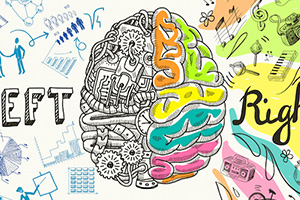 I’ll be the first to admit that I’ve taken a handful of online quizzes determining if I’m more right or left-brain dominant, and I’m sure I’m not alone in this.
I’ll be the first to admit that I’ve taken a handful of online quizzes determining if I’m more right or left-brain dominant, and I’m sure I’m not alone in this.
The theory of right-brain vs. left-brain is long running and truly compelling at that. However, how much do we actually know about the truth of brain functions and what makes up the hemisphere dominance theory?
What is Known About the Human Brain
The human brain is a complex organ made up of two halves responsible for intelligence, senses, movement and behavior. These halves are commonly called the right-brain and the left-brain, but should more correctly be termed ‘hemispheres’.
The right hemisphere controls our left side and processes what we see in our left eye, while the left hemisphere controls the right side and processes what our right eye sees. It has been long believed that the left and right hemispheres of our brain process information in different ways.
However, studies are now showing that this may not be exactly true and that the brain’s functions are far more complex than the theory of right-brain vs. left-brain dominance.
Neuropsychologist Roger W.Perry’s Work
The right-brain, left-brain theory originated from the work of neurobiologist and neuropsychologist Roger W. Sperry, who was awarded the Nobel Prize in 1981 for his findings. Sperry’s work found that the right hemisphere of the brain focuses on the visual, and processes information in an intuitive and simultaneous way, looking first at the whole picture then the details.
The left hemisphere focus however is verbal, processing information in an analytical and sequential way, looking first at the pieces and then putting them together to get the whole.
Sperry concluded that left-brain thinking is verbal and analytical and right-brain thinking is non-verbal and intuitive, using images rather than words. According to the left-brain, right-brain dominance theory, the right side of the brain is best at expressive and creative tasks.
Some of the abilities popularly associated with the right side brain include: recognizing faces, expressing emotions, music, reading emotions, color, images, intuition and creativity. The left side of the brain is considered to be adept at tasks that involve logic, language, and analytical thinking.
The left-brain is best described as being better at: language, logic, critical thinking, numbers, and reasoning. Right-brain dominant individuals tend to learn best by shared learning, group discussions, role-play/simulations, and experiments, while left-brain dominant individuals are said to best learn through analysis, research, realistic projects, and spreadsheets. (Above information based on Sperry’s theory.)
Recent Research on the Human Brain
Since Sperry’s findings, ideas about how the brain works have evolved and changed over time as researchers have learned more about how the brain operates. We understand the psychology notion of a left-brain and right-brain doesn’t capture the brain’s intimate working relationship and we now have a better sense that the two hemispheres of the brain communicate with one another via corpus callosum; a bundle of neural fibers that connect the brain’s two hemispheres.
Recent research has shown that the brain is not nearly as dichotomous as once thought. This proves that abilities are strongest when both halves of the brain work together.
Today, neuroscientists know that the two sides of the brain collaborate to perform a broad variety of tasks and that the two hemispheres constantly communicate. While activity is sometimes higher in certain critical brain regions, both sides of the brain are essentially equal in their activity on average.
It has been found true that some brain functions occur in more of the other side of the brain. For example, language tends to be on the left, attention more on the right. However, new studies show that individuals don’t tend to have a stronger left-sided or right-sided brain network, it seems to be determined more connection by connection – this is called Lateralization of Brain Function.






